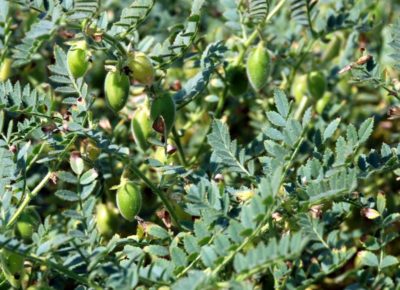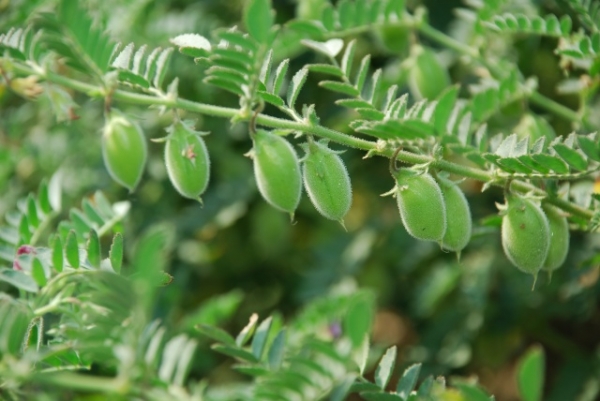प्याज की खेती एक महत्वपूर्ण कृषि प्रक� ...
Chickpea (Cicer arietinum) is an important pulse crop, particularly grown in India. Its cultivation is not only significant from a nutritional perspective but also serves as a profitable agricultural option for farmers. Chickpeas are a good source of protein, fiber, and various vitamins, making them beneficial for health. In this article, we will discuss chickpea cultivation in detail.
चना (Cicer arietinum) एक महत्वपूर्ण दलहन फसल है, जो विशेष रूप से भारत में उगाई जाती है। इसकी खेती न केवल पोषण की दृष्टि से महत्वपूर्ण है, बल्कि यह किसानों के लिए एक लाभकारी कृषि विकल्प भी है। चने की फसल प्रोटीन, फाइबर, और विभिन्न विटामिन्स का अच्छा स्रोत होती है, जो इसे स्वास्थ्य के लिए फायदेमंद बनाती है। इस लेख में हम चने की खेती के बारे में विस्तार से चर्चा करेंगे...
चने की खेती के लिए शुष्क और गर्म जलवायु सबसे उपयुक्त मानी जाती है। इसे 20 से 30 डिग्री सेल्सियस के तापमान में अच्छी वृद्धि होती है। मिट्टी की दृष्टि से, यह हल्की दोमट मिट्टी या काली मिट्टी में अच्छे से उगती है। मिट्टी का पीएच स्तर 6 से 7.5 के बीच होना चाहिए।

चने की बुवाई का समय अक्टूबर से नवंबर के बीच होता है। इस अवधि में तापमान और मिट्टी की नमी चने की वृद्धि के लिए अनुकूल होती है।
उच्च गुणवत्ता वाले बीज का चयन करना चने की खेती में महत्वपूर्ण है। किसान उच्च उपज देने वाली और रोग प्रतिरोधक किस्मों का चयन करें, जैसे कि 'कनक', 'पीबी-1', 'सीजी-5' आदि।
जुताई: खेत को अच्छे से जुताई करें ताकि मिट्टी भुरभुरी हो जाए।
खाद: खेत में अच्छी मात्रा में जैविक खाद जैसे गोबर की खाद मिलाएं।
बुवाई: बीजों को 30-45 सेमी की दूरी पर बोएं।
यह भी पढ़ें: चना की खेती में कीट एवं रोग प्रबंधन
चने की फसल में सिंचाई की आवश्यकता वर्षा पर निर्भर करती है। फसल के प्रारंभिक चरण में हल्की सिंचाईआवश्यक होती है, जबकि फूल आने के समय में सिंचाई का ध्यान रखना चाहिए।
फसल को सही मात्रा में उर्वरक प्रदान करना आवश्यक है। एनपीके (नाइट्रोजन, फास्फोरस, और पोटाश) का संतुलित अनुपात फसल की वृद्धि के लिए फायदेमंद होता है।
चने की खेती में प्रमुख रोगों में पत्ते का पीला होना और जड़ सड़न शामिल हैं। कीटों में दाने की चिड़िया और शत्रु कीट शामिल होते हैं। किसान जैविक कीटनाशकों और रोग निवारक उपायों का उपयोग कर सकते हैं।

चने की फसल आमतौर पर 4 से 5 महीनों में तैयार होती है। कटाई का समय तब होता है
चने की खेती एक लाभकारी व्यवसाय है, जो किसानों को आर्थिक लाभ प्रदान कर सकती है। इसके पोषण संबंधी लाभ और फसल की सरलता इसे एक लोकप्रिय विकल्प बनाते हैं। उचित खेती तकनीक और प्रबंधन से किसान चने की खेती से अच्छी आय प्राप्त कर सकते हैं।
अंत में, चने की खेती न केवल किसानों के लिए फायदेमंद है, बल्कि यह देश की खाद्य सुरक्षा में भी योगदान देती है। सही जानकारी और तकनीक के साथ, किसान इस फसल को सफलतापूर्वक उगाकर अपनी आर्थिक स्थिति को सुधार सकते हैं।
Chickpea cultivation thrives in dry and warm climates. It grows well at temperatures between 20 to 30 degrees Celsius. In terms of soil, it prefers light loamy or black soil. The pH level of the soil should be between 6 to 7.5.
The ideal time for sowing chickpeas is between October and November. During this period, the temperature and soil moisture are conducive for the growth of chickpeas.
Selecting high-quality seeds is crucial for chickpea cultivation. Farmers should choose high-yielding and disease-resistant varieties, such as 'Kanta', 'PB-1', and 'CG-5'.
Tillage: Prepare the field by plowing it well to make the soil loose.
Fertilizer: Add a good amount of organic manure, such as cow dung, to the soil.
Sowing: Sow the seeds at a distance of 30-45 cm apart.
The irrigation needs of chickpea crops depend on rainfall. Light irrigation is required during the initial growth stage, while care should be taken during the flowering stage.
Providing the right amount of fertilizer is essential. A balanced ratio of NPK (Nitrogen, Phosphorus, and Potassium) is beneficial for the growth of the crop.
Common diseases in chickpea cultivation include yellowing of leaves and root rot. Pests include pod borers and aphids. Farmers can use organic pesticides and disease management practices to control these issues.
Chickpeas are typically ready for harvest in 4 to 5 months. The right time to harvest is when the color of the pods turns light brown.
Chickpea cultivation is a profitable business that can provide economic benefits to farmers. Its nutritional advantages and the simplicity of cultivation make it a popular option. With proper farming techniques and management, farmers can earn a good income from chickpea cultivation.
In conclusion, chickpea farming is not only beneficial for farmers but also contributes to the food security of the country. With the right information and techniques, farmers can successfully grow this crop and improve their economic situation.
0
0
प्याज की खेती एक महत्वपूर्ण कृषि प्रक� ...
Potatoes are a versatile and widely consumed root vegetable, rich in nutrients such as carbohydrates ...
Garlic is a widely used spice and medicinal plant cultivated for centuries. It is known for its spic ...
Coriander farming offers lucrative returns for farmers due to its high demand in the culinary and me ...
September is an ideal month for sowing various vegetables that can be harvested in the cooler months ...
Ghiya, also known as bottle gourd, is a popular and nutritious vegetable grown in many parts of Indi ...
Tomato farming is a popular agricultural practice due to the high demand for tomatoes worldwide. It ...
खीरा की खेती एक लाभदायक कृषि व्यवसाय ह ...
अक्टूबर का महीना शरद ऋतु का प्रारंभ हो ...
Beetroot cultivation is a profitable agricultural venture that involves growing a nutritious root ve ...
Tauri, also known as Ridge Gourd, is a popular vegetable cultivated in many parts of Asia. It is hig ...
Eggplant, also known as Brinjal or Solanum melongena, is a widely cultivated vegetable in India, pri ...
Pea (Pisum sativum) is one of the major legume crops in India, used both as a vegetable and a pulse. ...
Sem, also known as ‘Beans,’ is a significant leguminous crop that is not only rich in nutrition ...
Bathua (Chenopodium album) is a nutritious leafy vegetable commonly grown during the winter season i ...
Lentils (Lens culinaris) are a valuable pulse crop grown in India during the Rabi season. Known for ...
The winter season is an excellent time for farmers, especially for cultivating vegetables. Vegetable ...
After harvesting rice, it is important for farmers to plan for the next crop. This is the time when ...
December marks the beginning of winter, making it an ideal time for vegetable farming. This season p ...
Red spinach, known as "लाल साग" in Hindi, is a nutrient-rich leafy vegetable that stands ...
There’s something special about enjoying freshly grown vegetables from your own home. It’s not o ...
February is an important time for agriculture, especially for farmers who are preparing for rabi and ...
Fruit drop or lack of fruiting in bottle gourd plants is a common issue, whether they are grown in s ...